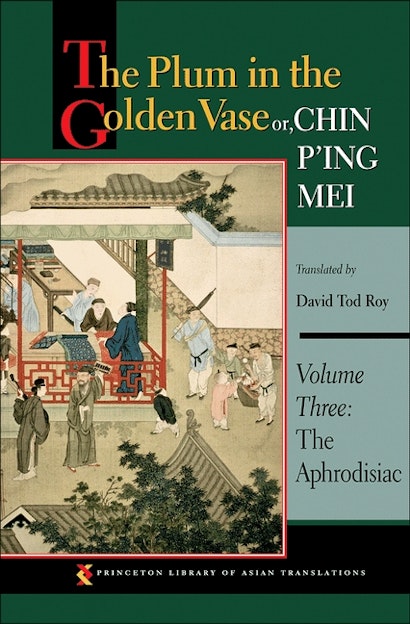This is the third volume in David Roy’s celebrated translation of one of the most famous and important novels in Chinese literature. The Plum in the Golden Vase or, Chin P’ing Mei is an anonymous sixteenth-century work that focuses on the domestic life of Hsi-men Ch’ing, a corrupt, upwardly mobile merchant in a provincial town, who maintains a harem of six wives and concubines. The novel, known primarily for its erotic realism, is also a landmark in the development of the narrative art form—not only from a specifically Chinese perspective but in a world-historical context.
Written during the second half of the sixteenth century and first published in 1618, The Plum in the Golden Vase is noted for its surprisingly modern technique. With the possible exception of The Tale of Genji (ca. 1010) and Don Quixote (1605, 1615), there is no earlier work of prose fiction of equal sophistication in world literature. Although its importance in the history of Chinese narrative has long been recognized, the technical virtuosity of the author, which is more reminiscent of the Dickens of Bleak House, the Joyce of Ulysses, or the Nabokov of Lolita than anything in earlier Chinese fiction, has not yet received adequate recognition. This is partly because all of the existing European translations are either abridged or based on an inferior recension of the text. This translation and its annotation aim to faithfully represent and elucidate all the rhetorical features of the original in its most authentic form and thereby enable the Western reader to appreciate this Chinese masterpiece at its true worth.
Replete with convincing portrayals of the darker side of human nature, it should appeal to anyone interested in a compelling story, compellingly told.
"[A] book of manners for the debauched. Its readers in the late Ming period likely hid it under their bedcovers."—Amy Tan, New York Times Book Review
"[I]t is time to remind ourselves that The Plum in the Golden Vase is not just about sex, whether the numerous descriptions of sexual acts throughout the novel be viewed as titillating, harshly realistic, or, in Mr. Roy's words, intended 'to express in the most powerful metaphor available to him the author's contempt for the sort of persons who indulge in them.' The novel is a sprawling panorama of life and times in urban China, allegedly set safely in the Sung dynasty, but transparently contemporary to the author's late sixteenth-century world, as scores of internal references demonstrate. The eight hundred or so men, women, and children who appear in the book cover a breath-taking variety of human types, and encompass pretty much every imaginable mood and genre—from sadism to tenderness, from light humor to philosophical musings, from acute social commentary to outrageous satire."—Jonathan Spence, New York Review of Books
"Clearly David Roy is the greatest scholar-translator in the field of premodern vernacular Chinese fiction. . . . The puns and various other kinds of word plays that abound in the Chin P'ing Mei are so difficult to translate that I can't help 'slapping the table in amazement' each time I see evidence of Roy's masterful rendition of them. . . . I recommend this book, in the strongest possible terms, to anyone interested in the novel form in general, in Chinese literature in particular, or in the translation of Chinese literature."—Shuhui Yang, Chinese Literature: Essays, Articles, and Reviews
"Racy, colloquial, and robustly scatalogical, [this translation] could only have been done now, when our literary language has finally shed its Victorian values. David Tod Roy enters with zest into the spirit and the letter of the original, quite surpassing . . . earlier versions."—Paul St. John Mackintosh, Literary Review
"Reading Roy's translation is a remarkable experience."—Robert Chatain, Chicago Tribune Review of Books
"[B]y virtue of both Roy's decision to translate the cihua version of the novel, and his manner of doing so, we have here an invaluable insight into the material and popular literary world of the late-Ming that will serve as a wonderful resource for students of the various aspects of this fascinating and rapidly changing period of late imperial Chinese history for many years to come."—Duncan Campbell, New Zealand Journal of Asian Studies
"Generations of readers will be grateful for Roy's monumental translation of the Chin P'ing Mei. The capstone in a distinguished career, this translation is a heroic and magnanimous act of scholarship. The encyclopedic annotation, which sets standards seldom matched by translation from any language, will be indispensable not only to the general reader but to scholars of this work."—Sophie Volpp, University of California, Berkeley
"In Volume Three of David Tod Roy's magnificent translation, corruption is in full swing in the world of Chin P'ing Mei. Roy brings to vivid life the clamoring voices of courtesans, wives, hangers-on, and officials, and, as no previous translator has done, he shows how the narrative weaves together literary genres from doggerel couplets to palace edicts. Roy's is the first translation in which Western readers can experience the full impact of this monumental novel."—Katherine Carlitz, University of Pittsburgh

